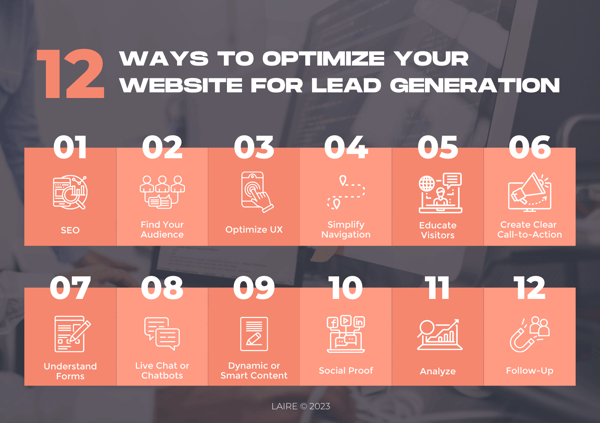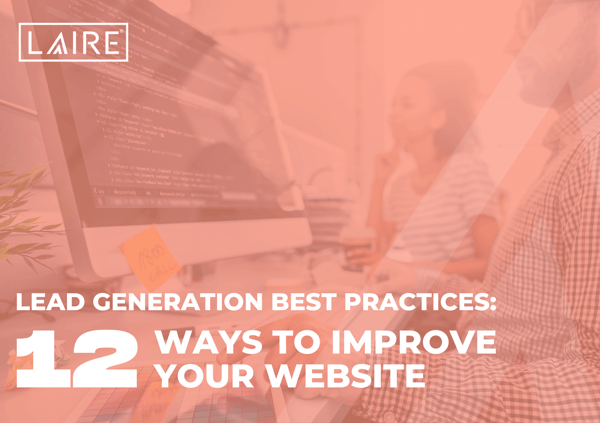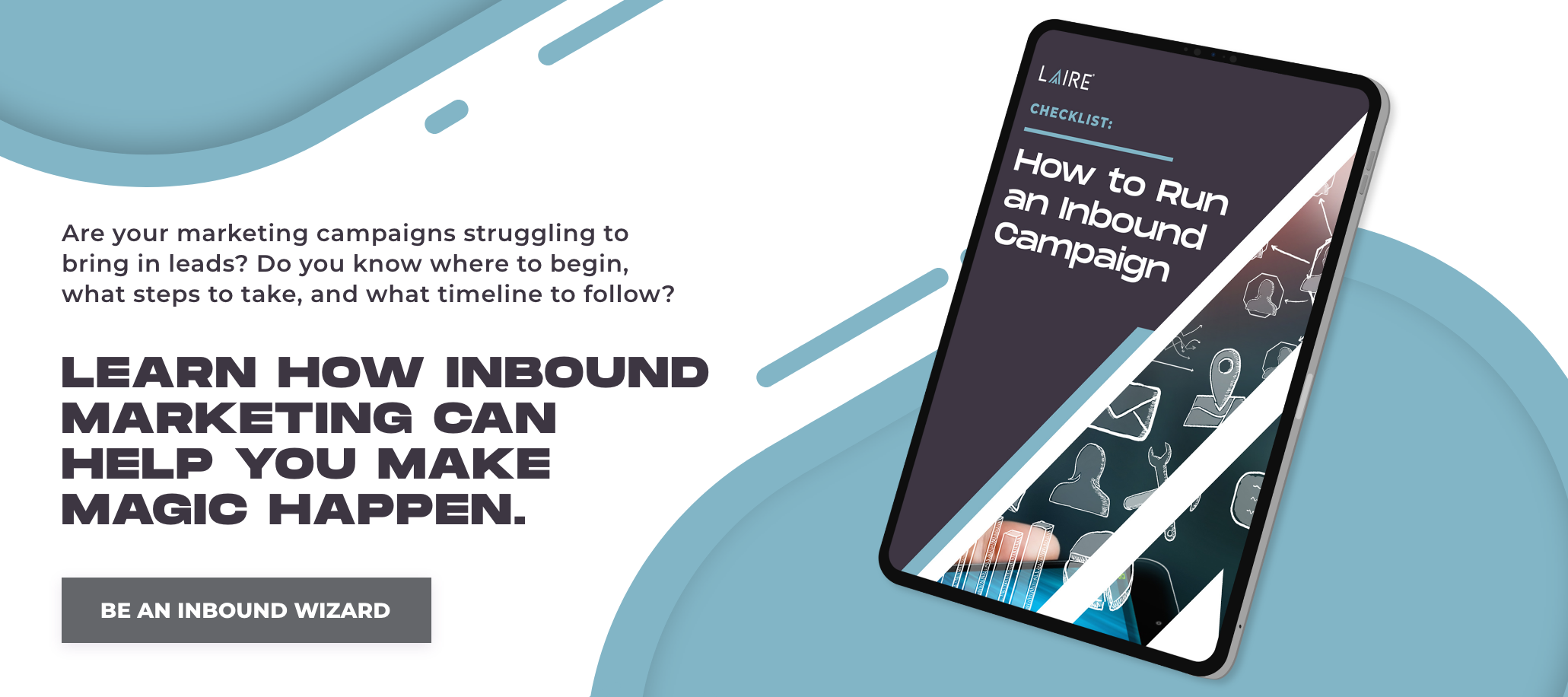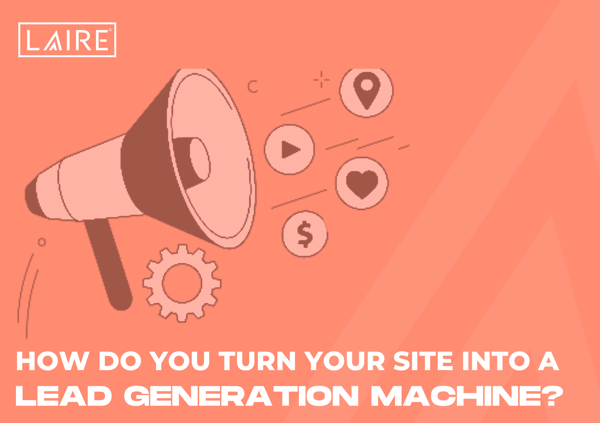Is there a clear recipe for lead generating website success? The short answer is no — but don’t lose hope! There are many levers you can pull to help turn your website visitors into customers.
Your site should be primed to support your business’ growth as a lead-capturing, revenue-generating machine. If it’s not, it may be time to take a look at some expert-level enhancements and upgrades to support your marketing efforts.
What Does the Lead Generation Process Look Like?
There’s a major difference between a website visitor and a lead. Think you know it? A lead is simply a website visitor who has interacted with some form of content on your site and willingly provided your company with more information about themselves. Typically, leads come in through forms submitted on landing pages.
While analyzing the number of website visitors is good, we know that the real opportunity for revenue lies within the leads generated. These individuals have shown interest in the content you produce and indicated that they want to know more from you in some form or fashion.
Now, let’s get back to the real reason you’re here. You want more qualified leads — and you want them now. To make that happen, you’ll want to take a look at the following expert-level upgrades.
12 B2B Lead Generation Best Practices
 Not only is every website different, but every potential lead that visits your site has a different user experience. Although it’s impossible to please every person who clicks on one of your webpages, there are best practices to follow for improving your lead generation.
Not only is every website different, but every potential lead that visits your site has a different user experience. Although it’s impossible to please every person who clicks on one of your webpages, there are best practices to follow for improving your lead generation.
By understanding and implementing the tips below, your website can begin to attract more visitors, convert them into leads, and turn leads into customers by closing more deals.
1. Make It Easy for Customers to Find You Online
If your potential customers are unable to find your business online, your chances of converting them into leads are slim. Fortunately, search engine optimization (SEO) can help your website be seen by the people that matter.
Start by conducting keyword research to identify the relevant terms and phrases that your ideal customers are searching for in your industry. Incorporate these keywords naturally into your website's content, including page titles, headings, and meta descriptions.
Build high-quality backlinks from reputable websites to increase your website's authority and visibility. Utilize on-page SEO techniques, such as optimizing images, improving internal linking, and creating a user-friendly site structure.
By implementing these SEO practices and thinking like your ideal customer, you can improve your website's search engine visibility and attract more organic traffic.
2. Speak to the Right Audience
Your website lead generation depends on visitors connecting with your content. The best way to accomplish this is by creating buyer personas. By outlining details of your ideal customers and their needs and pain points, you can better understand how to speak to them effectively through your website.
Say your business offers home remodeling. Having worked with many customers over the years, you have a pretty good idea of the type of person interested in your home remodeling services — they are homeowners, usually retired, and planning to stay in their home long term.
If the content on your website is focused on remodeling your home to improve its value before selling, that message most likely won’t resonate with your target audience.
3. Optimize UX for Desktop and Mobile
Once people are able to find you online, you’ll want to keep them on your website for as long as possible. The design and user experience (UX) of your website will help you do this.
But first, it’s important to note that more than 50% of all web users worldwide browse using a mobile device. For this reason, Google has adjusted its algorithm to favor websites optimized for mobile. Without a mobile-optimized website, not only will it be difficult for you to keep the interest of mobile website visitors, but your site will rank lower in Google’s search results.
In other words, if your website is not optimized to be viewed on mobile, you will lose out on SEO ranking opportunities and potential leads.
Here are tips to improve website usability on desktop and mobile:
- Keep the look and feel of your website consistent throughout. Your homepage should not look drastically different from your contact page. This consistency builds trust with your customers and helps establish your brand identity.
- Add relevant internal links to help your users to find what they are looking for quickly.
- Make sure that the background color and text color aren’t clashing. You don’t want your users to exit your site because they can’t read what’s on the page.
- Don’t let sections in text or images be placed in the wrong place because you forgot to make your site responsive on mobile.
4. Simplify Your Navigation Menu
On average, your website visitors will spend less than one minute on your site trying to find the information they’re looking for. If they cannot easily navigate your website, they’ll leave.
Your main navigation should be simple, with few menu options and a simplified dropdown list. A navigation menu with too many options can overwhelm your visitors. If they have to spend time thinking about where information would be located on your site, you have already lost their interest in your product or service.
5. Create High-Quality, Educational Content
You’ve probably heard the motto “always be closing.” When it comes to content marketing, your motto should be “always be helping.”
Buyers are in control of the sales cycle. When looking for a new product or service, they tend to start the process by doing research. They are looking for information about something, and your website has the opportunity to educate them about your industry.
Your content needs to engage and educate your website visitors. Overly salesy content or clickbait titles will be met with disappointment and few leads.
A blog is a great way to provide unique, informational content for your ideal customers in a language they can understand. Share in-depth information about your products or services, how-tos, industry news, and more. And make sure your blogs contain keywords that your customers would be searching for.
Do you have writer’s block? Artificial intelligence (AI) platform ChatGPT can be an invaluable tool in generating content ideas. You can explore different angles, ask questions, and receive creative suggestions to fuel your content creation process.
6. Provide a Clear Call to Action
A call-to-action (CTA) should drive your website visitors to complete a certain action. The action could be as simple as subscribing to your blog or something on a larger scale such as scheduling a consultation. Here is an example of a CTA:
A CTA can be in the form of hyperlinked text, a button, or an image. Whichever option you choose, it should be obvious that your CTAs are clickable.
The CTA should also relate to the content of your web page. For example, if you have a webpage that details the pricing of your product or service, your CTA should match the level of your visitor’s interest. The fact that they are reviewing your pricing is a strong indication that they’re serious about becoming a lead.
A solid CTA for this type of webpage could be scheduling a consultation or contacting your business. Alternatively, if someone is viewing your blog, your CTA should allow them to continue educating themselves, such as by downloading a free eBook.
If your website is missing CTAs altogether or they’re not aligned with your content, your website lead generation will suffer.
7. Understand the Dos and Don’ts of Forms
Forms like contact forms, registration forms, or even blog or newsletter subscription forms are a popular method of collecting online leads. They allow you to collect valuable information about your website audience and keep them moving down the marketing funnel toward your end goal: a sale.
To start generating leads using forms, identify the pages that are gaining the highest amounts of traffic on your website. These pages may be good candidates for a new form. Ensure that the content on the pages is engaging and gives the user just enough information to nurture them toward becoming a lead.
On your forms, you’ll want to at least collect the individual’s name and email address. Other form fields are not necessarily required, and sometimes long form fields actually deter a visitor from giving out their information.
8. Incorporate Live Chat or Chatbots
In the B2B space especially, you’ve probably seen and experienced the rise of live chat and chatbots.
Customers who chat are nearly three times more likely to buy from you. Beyond a boost in sales, you may also experience a higher customer satisfaction level due to a more immediate response. Customers typically leave the interaction feeling more satisfied and positive about your brand.
While this may not be a solution for every organization, the ones that are utilizing this functionality have enjoyed the ability to provide rapid responses and efficiently gain lead-qualifying information, while removing the typical buying objections. We recommend HubSpot’s free Chatbot Builder software to get started.
Keep in mind that you don’t necessarily need to push a live chat on every single page of your website. You don’t want to be too pushy — and every visitor is not going to want to leverage a chat feature.
9. Personalize With Dynamic or Smart Content
Today’s customers love personalization. A one-size-fits-all approach no longer does the trick. To make your marketing efforts more personal, consider including dynamic or smart content throughout your website.
Dynamic content is an additional method of delighting your customers and influencing them toward making a decision that will impact your revenue. Smart content leverages the valuable insights your users have provided you with such as interest, preferences, or historical behavior.
Having personalization tools like these in your arsenal of lead generation tactics will tailor the customer experience and create a unique buying experience. You can put dynamic content on landing pages, images, forms, and CTAs.
10. Add Credibility With Social Proof
The proof is in the pudding, right? Social proof adds validation to your business and the services you provide from the mouths of those you’ve already converted into customers.
By adding social proof like customer testimonials and case studies to your website, you can highlight successful business behavior and promote trust for potential customers. Reading the words of your current or previous customers can feel relatable to a new visitor and help boost your overall lead generation strategies.
11. Test, Analyze, and Reiterate
Turning your website into a lead generation machine is no overnight endeavor. To understand exactly what’s working for your visitors, consider introducing A/B tests with various features or upgrades to see what performs the best.
A/B testing can do wonders for your click-through rates. For example, are you struggling to settle on the language for one of your CTAs? Try out an initial call-to-action with one set of verbiage and later exchange it for alternate wording.
Something as simple as testing out the wording on a CTA, the fields in your submission form, the layout of a popular landing page, or the imagery you’re using can really make a difference.
In addition to A/B testing, diagnosing the health and performance of your website with data and analytics tools makes it possible to optimize your site with greater accuracy and intention.
The process of collecting and analyzing data can help you gain valuable insights into how a visitor is interacting with your website and what you may need to do to improve the user experience. This tip alone should be considered a major step towards becoming a lead generation machine.
12. Know That the Key to Success Is in the Follow-Up
Remember, your leads are only ever as good as your nurturing efforts. The true key to success is in the follow-up. If you’ve collected information from a lead, it’s critical that you don’t stop there. No lead will magically turn into a customer without any effort on the backend.
Lead nurturing emails can work really well when done correctly. Once a lead comes in, you can enroll them in an email marketing workflow to provide them with valuable content and keep your business front of mind.
Your lead may not be ready to make a purchase decision at the time of their form submission, so it’s important to steadily nurture them until they are.
Turn Your Website Into a Lead Generation Machine
 It’s not enough just to learn about best practices for lead generation — you have to commit to taking action.
It’s not enough just to learn about best practices for lead generation — you have to commit to taking action.
If you’re feeling overwhelmed and not sure where to start, LAIRE can help. We use informed, data-driven strategies to design and develop your custom website. Then, our team of inbound marketing experts will evaluate and optimize your content for maximum performance.
Ready to see sustainable growth in your company? Request a free website strength assessment today to get started.


